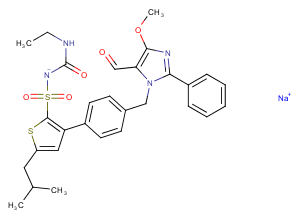Shopping Cart
- Remove All
 Your shopping cart is currently empty
Your shopping cart is currently empty

AVE 0991 competes for high-affinity binding of [125I]-Ang-(1-7) to bovine aortic endothelial cell membranes, with IC50 of 21±35 nM. AVE 0991 sodium salt is a nonpeptide and orally active Ang-(1-7) receptor Mas agonist.

| Pack Size | Price | Availability | Quantity |
|---|---|---|---|
| 2 mg | $142 | 5 days | |
| 5 mg | $247 | 5 days | |
| 10 mg | $377 | 5 days | |
| 1 mL x 10 mM (in DMSO) | $329 | 5 days |
| Description | AVE 0991 competes for high-affinity binding of [125I]-Ang-(1-7) to bovine aortic endothelial cell membranes, with IC50 of 21±35 nM. AVE 0991 sodium salt is a nonpeptide and orally active Ang-(1-7) receptor Mas agonist. |
| Targets&IC50 | Ang (1-7) receptor:21±35 nM |
| In vitro | AVE 0991 is a nonpeptide compound that elicits effects similar to Ang-(1-7) on the endothelium. The peak concentrations of NO and O2- release by AVE 0991 sodium salt and Ang-(1-7) (both 10 μM) are not significantly different (NO: 295±20 and 270±25 nM; O2-: 18±2 and 20±4 nM), but the amount of bioactive NO released is approximately five times higher for AVE 0991. Both AVE 0991 and unlabeled Ang-(1-7) compete for high-affinity binding of [125I]-Ang-(1-7) to bovine aortic endothelial cell membranes, with IC50s of 21±35 and 220±280 nM, respectively[1]. |
| In vivo | AVE 0991 (AVE) demonstrates an antidiuretic effect marked by an elevated urine osmolality (1669±231.0 mOsm/KgH2O compared to 681.1±165.8 mOsm/KgH2O in vehicle-treated mice; P<0.01) and significantly reduces water diuresis in WT mice (0.06±0.03 mL versus 0.27±0.05 mL; n=9 per group; P<0.01). Similarly, in water-loaded Swiss mice, AVE 0991 administration (0.58 nmol/g) significantly lowers urinary volume (0.13±0.05 mL [n=16] versus 0.51±0.04 mL [n=40]; P<0.01). However, the antidiuretic effect is negated by the genetic deletion of Mas (0.37±0.10 mL [n=9] versus 0.27±0.03 mL [n=11] in AVE 0991-treated mice). Furthermore, a week-long treatment with AVE-0991 notably decreases perfusion pressure (56.55±0.86 vs. 68.73±0.69 mmHg in vehicle-treated rats), enhances systolic tension (11.40±0.05 vs. 9.84±0.15 g), increases both the rate of tension rise (+dT/dt; 184.30±0.50 vs. 155.20±1.97 g/s) and fall (−dT/dt; 179.60±1.39 vs. 150.80±2.42 g/s), and slightly raises heart rate (220.40±0.71 vs. 214.20±0.74 beats/min in vehicle-treated rats). |
| Molecular Weight | 602.7 |
| Formula | C29H31N4NaO5S2 |
| Cas No. | 306288-04-0 |
| Relative Density. | no data available |
| Storage | Powder: -20°C for 3 years | In solvent: -80°C for 1 year | Shipping with blue ice. | ||||||||||||||||||||||||||||||
| Solubility Information | DMSO: 55 mg/mL (91.26 mM), Sonication is recommended. | ||||||||||||||||||||||||||||||
Solution Preparation Table | |||||||||||||||||||||||||||||||
DMSO
| |||||||||||||||||||||||||||||||

Copyright © 2015-2025 TargetMol Chemicals Inc. All Rights Reserved.